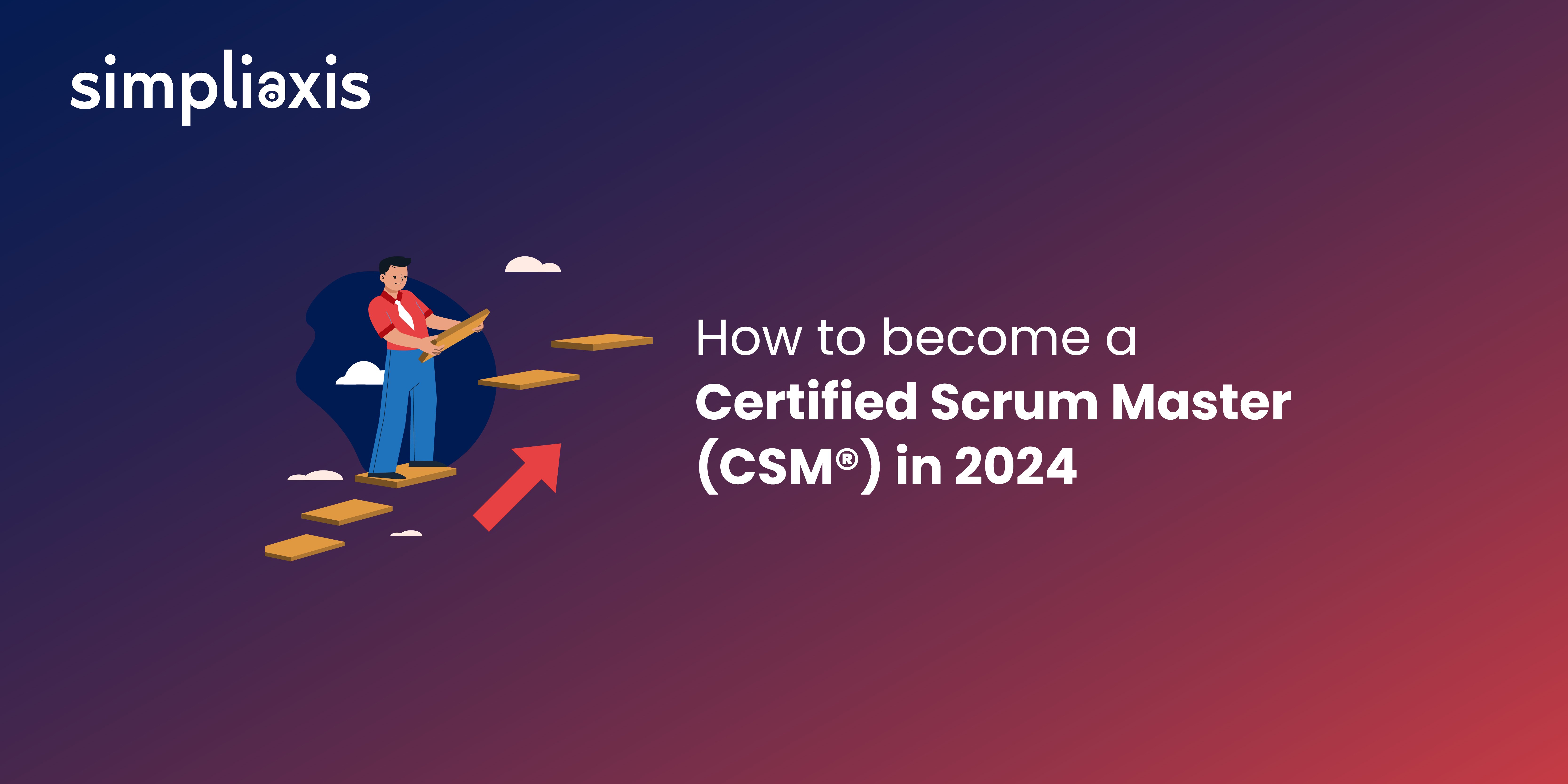In the ever-evolving domain of project management, the role of a Certified Scrum Master (CSM®) has gained significant prominence. As businesses worldwide embrace agile methodologies to enhance flexibility and efficiency, the demand for skilled Scrum Masters is on the rise. This comprehensive guide provides aspiring professionals with a step-by-step roadmap to becoming a Certified Scrum Master in 2024, including key insights, essential skills, and the latest trends in agile project management.
Also, check:Scrum Master skills
What Is The Role of a Certified Scrum Master (CSM®)?
Scrum Master plays a crucial role in facilitating agile development teams, ensuring adherence to Scrum principles, and facilitating a culture of continuous improvement. They act as servant-leaders, removing impediments, promoting collaboration, and enabling teams to deliver high-value products. Understanding the fundamentals of Scrum and the responsibilities of a Scrum Master is the first step towards certification.
Are There Any Prerequisites For Becoming a CSM?
While there are no strict prerequisites for pursuing a Scrum Master certification, having a foundational understanding of agile principles and practices is beneficial. Essential skills for a successful Scrum Master include strong communication, leadership, and problem-solving abilities. Analyzing industry trends and data on the demand for Scrum Masters can help aspiring professionals gauge the relevance of this certification in their career path.
How Do You Choose The Right Scrum Master Certification?
Selecting the appropriate Scrum Master certification is a crucial decision. Two widely recognized certifications are the Certified Scrum Master (CSM®) and the Professional Scrum Master (PSM®). Both certifications have their unique features and requirements. A comparative table can assist in making an informed choice:
Certification | Certification Body | Eligibility | Exam Format | Renewal Requirement |
CSM | Simpliaxis (Scrum Alliance) | No formal prerequisites | Multiple-choice questions | Renew every two years with Scrum Education Units (SEUs) |
PSM | Simpliaxis (Scrum.org) | No formal prerequisites | Multiple-choice questions | No renewal required |
Is Online CSM Certification Better Than Offline?
You'll need to complete a certified training program to prepare for the CSM certification. Options include online courses and in-person workshops. Consider your learning style, schedule, and budget when choosing between these formats. Online courses offer flexibility, allowing you to learn at your own pace, while in-person workshops provide a more immersive experience with real-time interaction. Explore reputable training providers, ensuring their programs align with the latest Agile and Scrum principles.
What Are Various Scrum Master Certification Options?
1. Certified Scrum Master (CSM®) Certification
- CSM Certification is offered by Scrum Alliance.
- Widely recognized in the industry.
- Requires attendance of a two-day CSM training.
- Involves a 50-question multiple-choice exam.
- Successful completion grants a two-year CSM certification.
2. Professional Scrum Master™ (PSM) Certification
- PSM certification is Provided by Scrum.org.
- No mandatory training; self-study is an option.
- The exam consists of 80 questions.
- Different levels (PSM I, PSM II, PSM III) cater to various skill levels.
- No renewal requirement.
Click here to know more aboutPSM certification.
The Process to Become a Certified Scrum Master
Becoming a Certified Scrum Master (CSM) involves several steps. One of the major steps in this process is to prepare for the certification exam. Preparing for a Scrum Master certification exam requires a multifaceted strategy that encompasses various study resources, practice tests, and simulations. In this section, we'll delve deeper into each aspect to ensure a thorough and effective preparation.
A. Study Resources:
1. Utilize official Scrum Guides and documentation: The Scrum Guide is the foundational document for understanding Scrum. Familiarize yourself with its content, paying close attention to roles, events, and artifacts in the Scrum framework.
2. Engage in online courses and tutorials: Enroll in reputable online courses designed to cover the intricacies of Scrum.
3. Join Scrum communities and forums for discussions: Participate in online forums and communities where Scrum professionals share insights and experiences.
4. Explore books on Scrum and agile methodologies: Expand your knowledge by delving into books dedicated to Scrum and agile practices.
5. Study Smart for the Exam: The CSM® certification exam is the gateway to officially becoming a Scrum Master. Develop a study plan that covers all exam objectives, including Scrum roles, events, and artifacts. Utilize resources the training program provides, such as study guides, practice exams, and interactive simulations. Consider joining online forums or study groups to exchange insights with fellow aspirants.
Emphasizing understanding the underlying principles driving Scrum practices, rather than relying on memorization, proves highly beneficial when pursuing a Certified Scrum Master (CSM®) certification.
B. Practice Tests and Simulations:
1. Take advantage of practice exams: Numerous online platforms offer practice exams that mimic the format and difficulty of the actual certification test. Websites such as Scrum.org, Scrum Alliance and Simpliaxis and other reputable providers can be instrumental in gauging your preparedness.
2. Participate in mock Scrum Master scenarios: Engage in mock scenarios that simulate real-world situations a Scrum Master might encounter. This could involve role-playing with peers or joining virtual simulations that replicate the challenges faced in a Scrum environment.
3. Use online platforms offering simulated certification exams: Dedicated platforms provide simulated certification exams, allowing you to experience the exam environment beforehand. This not only aids in familiarization but also helps in refining your time management skills and reducing exam anxiety.
C. Additional Tips for Exam Preparation:
1. Create a Study Plan: Develop a structured study plan that allocates sufficient time to each topic.
2. Identify Weaknesses: Regularly assess your understanding by taking quizzes or self-assessment tests.
3. Stay Updated: Stay updated with the latest developments, case studies, and changes in the Scrum framework to ensure your knowledge is current.
4. Seek Guidance: If you encounter challenges or have questions, don't hesitate to seek guidance from experienced Scrum practitioners, mentors, or instructors.
D. Registering for the Certification Exam:
Once adequately prepared, aspiring Scrum Masters can register for their chosen certification exam. Be mindful of any registration deadlines and requirements set by the certification body.
E. What to Expect on Exam Day
As you approach the exam date, familiarize yourself with the logistics. The CSM® certification exam is typically a timed online test with a mix of multiple-choice and true/false questions. Make sure that you have a stable internet connection and a stable environment for the duration of the exam.
As mentioned above, take advantage of any practice exams provided by your training program to simulate the exam environment and assess your readiness.
Lastly!
Becoming a Certified Scrum Master (CSM®) in 2024 involves a strategic and well-planned approach. By understanding the role, acquiring essential skills, choosing the right certification, and staying abreast of industry trends, aspiring Scrum Masters can embark on a fulfilling and successful career in agile project management. Certification is not just a milestone; it's a gateway to continuous learning and evolution in the dynamic field of Scrum. With dedication and continuous improvement, the journey to becoming a Certified Scrum Master (CSM®) promises a rewarding professional adventure.



















